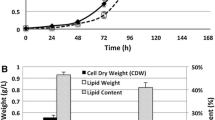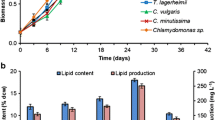Abstract
Microalgal oil is a potential energy source because it can be easily converted to fatty acid methyl ester or hydrocarbon type of diesel, and it is produced with relatively higher productivity compared with oil from plants and animals. Heterotrophic growth of microalgae is superior due to its high final product concentration; however, the cost of the raw materials is unacceptable if sugar is utilized as the carbon source. The aim of this study is to optimize the lipid accumulation of Chlorella protothecoides by using carbon sources other than glucose in heterotrophic and mixotrophic cultures. Different factors such as different carbon sources, carbon to nitrogen ratio, initial pH level, salinity, and rotational speed are studied in affecting the cell growth and the oil accumulation. Our experiments revealed that the heterotrophic and mixotrophic cultures of C. protothecoides grew better than autotrophic cultures. C. protothecoides can grow on glycerol or acetate, as well as on glucose. Several stress factors were confirmed or discovered to significantly increase the lipid content of microalgae cells. The replacement of glycerol and acetate as carbon sources for microalgae cultivations provides potential for waste utilization: glycerol from biodiesel industry and acetate from biohydrogen production.









Similar content being viewed by others
References
Peng, W. M., Wu, Q. Y., & Tu, P. G. (2000). Effects of temperature and holding time on production of renewable fuels from pyrolysis of Chlorella protothecoides. Journal of Applied Phycology, 12, 147–152.
Miao, X. L., & Wu, Q. Y. (2004). High yield bio-oil production from fast pyrolysis by metabolic controlling of Chlorella protothecoides. Journal of Biotechnology, 110, 85–93.
Angenent, L. T., Karim, K., Al-Dahhan, M. H., & Domiguez-Espinosa, R. (2004). Production of bioenergy and biochemicals from industrial and agricultural wastewater. Trends in Biotechnology, 22, 477–485.
Chisti, Y. (2007). Biodiesel from microalgae. Biotechnology Advances, 25, 294–306.
Du, Z. W., Li, H. R., & Gu, T. Y. (2007). A state of the art review on microbial fuel cells: A promising technology for wastewater treatment and bioenergy. Biotechnology Advances, 25, 464–482.
Boddiger, D. (2007). Boosting biofluel crops could threaten food security. Lancet, 370, 923–924.
Stein, K. (2007). Food vs biofuel. Journal of the American Dietetic Association, 107, 1870.
Miao, X. L., & Wu, Q. Y. (2006). Biodiesel production from heterotrophic microalgal oil. Bioresource Technology, 97, 841–846.
Xu, H., Miao, X. L., & Wu, Q. Y. (2006). High quality biodiesel production from a microalga Chlorella protothecoides by heterotrophic growth in fermenters. Journal of Biotechnology, 126, 499–507.
Li, X. F., Xu, H., & Wu, Q. Y. (2007). Large-scale biodiesel production from microalga Chlorella protothecoides through heterotropic cultivation in bioreactors. Biotechnology and Bioengineering, 98, 764–771.
Vasudevan, P. T., & Briggs, M. (2008). Biodiesel production-current state of the art and challenges. Journal of Industrial Microbiology & Biotechnology, 35, 421–430.
Hossain, A. B. M. S., & Boyce, A. N. (2009). Biodiesel production from waste sunflower cooking oil as an environmental recycling process and renewable energy. Bulgarian Journal of Agricultural Science, 15, 313–318.
Fu, B. S., Gao, L. J., Niu, L., Wei, R. P., & Xiao, G. M. (2009). Biodiesel from waste cooking oil via heterogeneous superacid catalyst SO42-/ZrO2. Energy & Fuels, 23, 569–572.
Chisti, Y. (2008). Biodiesel from microalgae beats bioethanol. Trends in Biotechnology, 26, 126–131.
Foglia, T. A., & Barr, P. A. (1976). Decarbonylation dehydration of fatty-acids to alkenes in presence of transition-metal complexes. Journal of the American Oil Chemists' Society, 53, 737–741.
Maier, W. F., Roth, W., Thies, I., & Schleyer, P. V. (1982). Hydrogenolysis. 4. Gas-phase decarboxylation of carboxylic-acids. Chemische Berichte-Recueil, 115, 808–812.
Snare, M., Kubickova, I., Maki-Arvela, P., Chichova, D., Eranen, K., & Murzin, D. Y. (2008). Catalytic deoxygenation of unsaturated renewable feedstocks for production of diesel fuel hydrocarbons. Fuel, 87, 933–945.
Borowitzka, M. A. (1999). Commercial production of microalgae: Ponds, tanks, tubes and fermenters. Journal of Biotechnology, 70, 313–321.
O'Connor, W., & Diemar, J. (1991). Techniques for the mass culture of marine microalgae. NSWAF Advisory Bulletin, 1–3.
Chovancikova, M., & Simek, V. (2001). Effects of high-fat and Chlorella vulgaris feeding on changes in lipid metabolism in mice. Biologia, 56, 661–666.
Lee, Y. K. (2001). Microalgal mass culture systems and methods: Their limitation and potential. Journal of Applied Phycology, 13, 307–315.
Syrett, P. J., Merrett, M. J., & Bocks, S. M. (1964). Assimilation of acetate by Chlorella vulgaris. Journal of Experimental Botany, 15, 35.
Matsuka, M., Miyachi, S., & Hase, E. (1969). Acetate metabolism in process of acetate-bleaching of Chlorella protothecoides. Plant & Cell Physiology, 10, 527.
Matsuka, M., & Hase, E. (1970). Some aspects of metabolism of glucose and acetate in Chlorella-protothecoides. Bulletin of the Faculty of Agriculture Tamagawa University, 10, 41–48.
Ferraz, C. A. M., Frey, K. G., & Aquarone, E. (1983). Influence of the sodium-acetate on the production of cellular lipids and uptake of Mn and Fe in Chlorella-vulgaris. Revista de Microbiologia, 14, 78–83.
Ceron Garcia, M. C., Camacho, F. G., Miron, A. S., Sevilla, J. M. F., Chisti, Y., & Grima, E. M. (2006). Mixotrophic production of marine microalga Phaeodactylum tricornutum on various carbon sources. Journal of Microbiology and Biotechnology, 16, 689–694.
Liang, Y. N., Sarkany, N., & Cui, Y. (2009). Biomass and lipid productivities of Chlorella vulgaris under autotrophic, heterotrophic and mixotrophic growth conditions. Biotechnological Letters, 31, 1043–1049.
Chulanovskaya, M. V., Glagoleva, T. A., & Zalenskii, O. V. (1981). Effect of Atp on photoassimilation of glucose by Chlorella. Soviet Plant Physiology, 28, 548–555.
de Morais, M. G., & Costa, J. A. V. (2007). Carbon dioxide fixation by Chlorella kessleri, C-vulgaris, Scenedesmus obliquus and Spirulina sp cultivated in flasks and vertical tubular photobioreactors. Biotechnological Letters, 29, 1349–1352.
Baker, J. E., & Thompson, J. F. (1961). Assimilation of ammonia by nitrogen-starved cells of Chlorella vulgaris. Plant Physiology, 36, 208.
Bach, M. K. (1961). Apparent reversal of xanthine oxidase action in Chlorella vulgaris starved of nitrogen. Nature, 189, 485.
Aslan, S., & Kapdan, I. K. (2006). Batch kinetics of nitrogen and phosphorus removal from synthetic wastewater by algae. Ecological Engineering, 28, 64–70.
Dihoru, A. (1974). Effect of magnesium and carbon di oxide on photosynthesis and development of some uni cellular green algae. Studii si Cercetari de Biologie, 26, 183–186.
Bilgrami, K. S., & Kumar, S. (1997). Effects of copper, lead and zinc on phytoplankton growth. Biologia Plantarum, 39, 315–317.
Borowitzka, L. J., Moulton, T. P., Borowitzka, M. A. (1986). Salinity and the Commercial Production of Beta Carotene from Dunaliella-Salina. In W. R. Barclay, & R. P. Mcintosh (Ed.), Beihefte Zur Nova Hedwigia, Heft 83 (Supplements to Nova Hedwigia, No. 83). Algal Biomass Technologies: An Interdisciplinary Perspective; Workshop on the Present Status and Future Directions for Biotechnologies Bas (pp. 224–229).
Bolsunovskii, A., & Zotina, T. (1996). Effect of salinity on the growth of the cyanobacterium Spirulina platensis in mono- and mixed cultures. Mikrobiologiya, 65, 421–422.
Alyabyev, A. J., Loseva, N. L., Gordon, L. K., Andreyeva, I. N., Rachimova, G. G., Tribunskih, V. I., et al. (2007). The effect of changes in salinity on the energy yielding processes of Chlorella vulgaris and Dunaliella maritima cells. Thermochimica Acta, 458, 65–70.
Giordano, M., Davis, J. S., Faranda, F., & Bowes, G. (1991). Response of Dunaliella-Salina grown at high and low carbon dioxide to different sources of nitrogen. Plant Physiology (Rockville), 96, 51.
Papanikolaou, S., & Aggelis, G. (2002). Lipid production by Yarrowia lipolytica growing on industrial glycerol in a single-stage continuous culture. Bioresource Technology, 82, 43–49.
Lin, C. Y., & Lay, C. H. (2004). Carbon/nitrogen-ratio effect on fermentative hydrogen production by mixed microflora. International Journal of Hydrogen Energy, 29, 41–45.
Xiong, W., Li, X. F., Xiang, J. Y., & Wu, Q. Y. (2008). High-density fermentation of microalga Chlorella protothecoides in bioreactor for microbio-diesel production. Applied Microbiology and Biotechnology, 78, 29–36.
Hogetsu, D., & Miyachi, S. (1977). Effects of Co2 concentration during growth on subsequent photosynthetic Co2 fixation in Chlorella. Plant & Cell Physiology, 18, 347–352.
Borowitzka Michael, A., & Borowitzka, L. J. (1988). Micro-algal biotechnology. Cambridge: Cambridge University Press.
Becker, E. W. (1994). Microalgae: Biotechnology and microbiology. Cambridge: Cambridge University Press.
Shi, X. M., Zhang, X. W., & Chen, F. (2000). Heterotrophic production of biomass and lutein by Chlorella protothecoides on various nitrogen sources. Enzyme and Microbial Technology, 27, 312–318.
Gonzalez-Bashan, L. E., Lebsky, V. K., Hernandez, J. P., Bustillos, J. J., & Bashan, Y. (2000). Changes in the metabolism of the microalga Chlorella vulgaris when coimmobilized in alginate with the nitrogen-fixing Phyllobacterium myrsinacearum. Canadian Journal of Microbiology, 46, 653–659.
Illman, A. M., Scragg, A. H., & Shales, S. W. (2000). Increase in Chlorella strains calorific values when grown in low nitrogen medium. Enzyme and Microbial Technology, 27, 631–635.
Chen, G. Q., & Chen, F. (2006). Growing phototrophic cells without light. Biotechnological Letters, 28, 607–616.
Takagi, M., Watanabe, K., Yamaberi, K., & Yoshida, T. (2000). Limited feeding of potassium nitrate for intracellular lipid and triglyceride accumulation of Nannochloris sp UTEX LB1999. Applied Microbiology and Biotechnology, 54, 112–117.
Dohler, G. (1981). Effect of oxygen on photosynthetic-Co2 fixation by Chlorella-vulgaris. Biochemie und Physiologie der Pflanzen, 176, 439–446.
Blanco, A. M., Moreno, J., Del Campo, J. A., Rivas, J., & Guerrero, M. G. (2007). Outdoor cultivation of lutein-rich cells of Muriellopsis sp in open ponds. Applied Microbiology and Biotechnology, 73, 1259–1266.
Shi, X. M., Wu, Z. Y., & Chen, F. (2006). Kinetic modeling of lutein production by heterotrophic Chlorella at various pH and temperatures. Molecular Nutrition & Food Research, 50, 763–768.
Hu, B., Zhou, X., Forney, L., & Chen, S. L. (2009). Changes in microbial community composition following treatment of methanogenic granules with chloroform. Environmental Progress & Sustainable Energy, 28, 60–71.
Khotimchenko, S. V., & Yakovleva, I. M. (2005). Lipid composition of the red alga Tichocarpus crinitus exposed to different levels of photon irradiance. Phytochemistry, 66, 73–79.
Renaud, S. M., Thinh, L. V., Lambrinidis, G., & Parry, D. L. (2002). Effect of temperature on growth, chemical composition and fatty acid composition of tropical Australian microalgae grown in batch cultures. Aquaculture, 211, 195–214.
Liu, Z. Y., Wang, G. C., & Zhou, B. C. (2008). Effect of iron on growth and lipid accumulation in Chlorella vulgaris. Bioresource Technology, 99, 4717–4722.
Hsieh, C. H., & Wu, W. T. (2009). Cultivation of microalgae for oil production with a cultivation strategy of urea limitation. Bioresource Technology, 100, 3921–3926.
Shi, X. M., Chen, F., Yuan, J. P., & Chen, H. (1997). Heterotrophic production of lutein by selected Chlorella strains. Journal of Applied Phycology, 9, 445–450.
Shi, X. M., Jiang, Y., & Chen, F. (2002). High-yield production of lutein by the green microalga Chlorella protothecoides in heterotrophic fed-batch culture. Biotechnology Progress, 18, 723–727.
Running, J. A., Severson, D. K., & Schneider, K. J. (2002). Extracellular production of L-ascorbic acid by Chlorella protothecoides, Prototheca species, and mutants of P-moriformis during aerobic culturing at low pH. Journal of Industrial Microbiology & Biotechnology, 29, 93–98.
Carlsson, A. S., van Beilen, J. B., Moller, R., Clayton, D. (2007). Micro- and Macro-algae: Utility for industrial applications. University of York. CNAP. Ref Type: Report.
Borowitzka, M. A., & Borowitzka, L. J. (1988). Microalgal biotechnology. Cambridge: Cambridge University Press.
Chi, Z. Y., Hu, B., Liu, Y., Frear, C., Wen, Z. Y., & Chen, S. L. (2007). Production of omega-3 polyunsaturated fatty acids from cull potato using an algae culture process. Applied Biochemistry and Biotechnology, 137, 805–815.
Weldy, C.S., Huesemann M. (2010). Lipid production by Dunaliella salina in batch culture: effects of nitrogen limitation and light intensity. U.S. Department of Energy Journal of Undergraduate Research, 115–122. Ref Type: Magazine Article.
Author information
Authors and Affiliations
Corresponding author
Rights and permissions
About this article
Cite this article
Heredia-Arroyo, T., Wei, W. & Hu, B. Oil Accumulation via Heterotrophic/Mixotrophic Chlorella protothecoides . Appl Biochem Biotechnol 162, 1978–1995 (2010). https://doi.org/10.1007/s12010-010-8974-4
Received:
Accepted:
Published:
Issue Date:
DOI: https://doi.org/10.1007/s12010-010-8974-4




